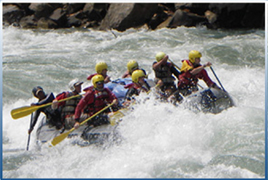River Rafting
For people wishing to have fun with rafting, Nepal is the perfect place. Because of its fast flowing, beautiful and powerful rivers rafting will be the perfect fun to make your heart feel happy and enjoyable. The rivers of Nepal are very perfect one for rafting because of having their sources in the glaciers draining the slopes of one or other of the great peaks, these mighty and powerful rivers cut through the Nepali countryside, swift and turbulent sometimes, placid and calm at others, providing an exhilarating means of viewing and ever-changing scenery.
White Water River Rafting:
|
|
Equipments and Services we provide for the trip
|
Grading System
|
Class 1 |
Easy: Moving water with occasional small rapids. Few or no obstacles. |
|
Class 2 |
Moderate: Small Rapids with regular waves. Some maneuvering required but easy to navigate. |
|
Class 3 |
Difficult: Rapids with irregular waves and hazards that need avoiding. More difficult maneuvering required but routes are normally obvious. Scouting from shore is occasionally required. |
|
Class 4 |
Very Difficult: Large rapids that require careful maneuvering. Dangerous hazards. Scouting from shore is often necessary and rescue is difficult. Kayakers should be able to roll. Turbulent water and large irregular waves may flip rafts. In the event of a mishap there is significant risk of loss damage and/or injury. |
|
Class 5 |
Extremely Difficult: Difficulties of class 5 carried out to the extreme of navigability. Might possibly (but not probably) be run by a team of experts at the right water level, in the right conditions with all possible safety precautions, but still with considerable hazard to life. |
|
Class 6 |
Extremely difficult but can be run by extremely Rafters exports. |
*For consistency river grades are taken from the guide book "Whitewater Nepal Book".
-
What our client says
Excellent and Personal Service
“I have recently completed the Manaslu trek with Himalayan RST expeditions and would recommend everyone to use them. The itinerary was clearly explained, as were all the costs, the transport and other requirements. The jeeps…[ more ]
Laurence Wilbraham, United Kingdom -
From our travel blog
01OctIs Nepal still safe for Peak Climbing after Devastating Earthquake?
There are 1700 Peaks (the major portion of the Mountain range.) in Nepal, Himalayas that exceed 5500 meters to 8848m (29,028ft) in height above sea level.. Presently , Only 282 of these peaks are open to expeditions . This… [ more ]










